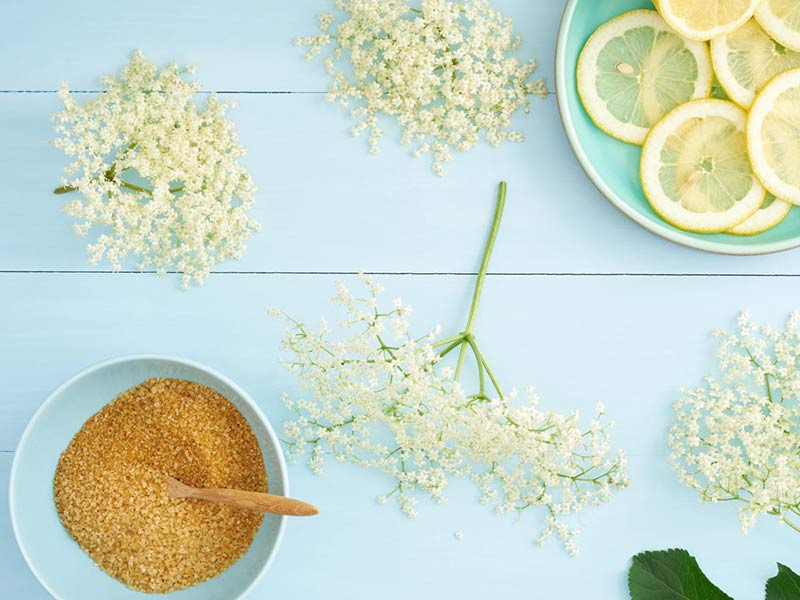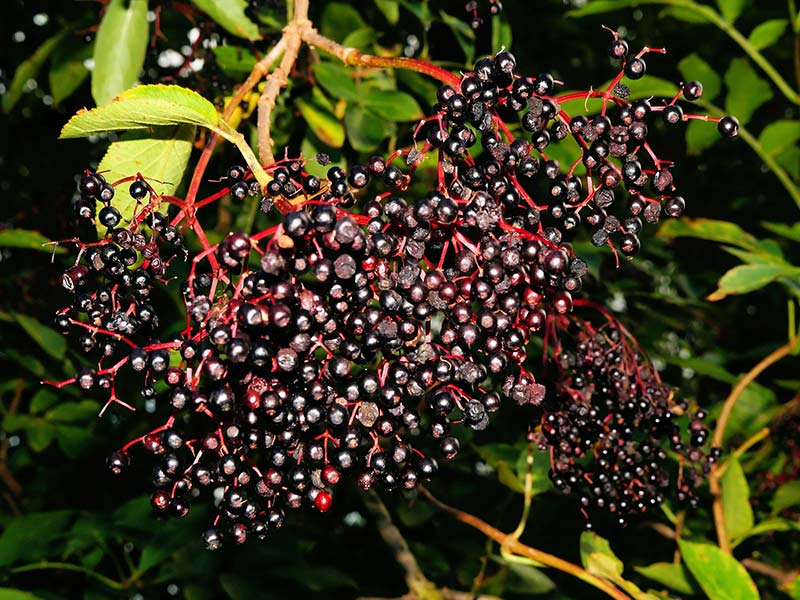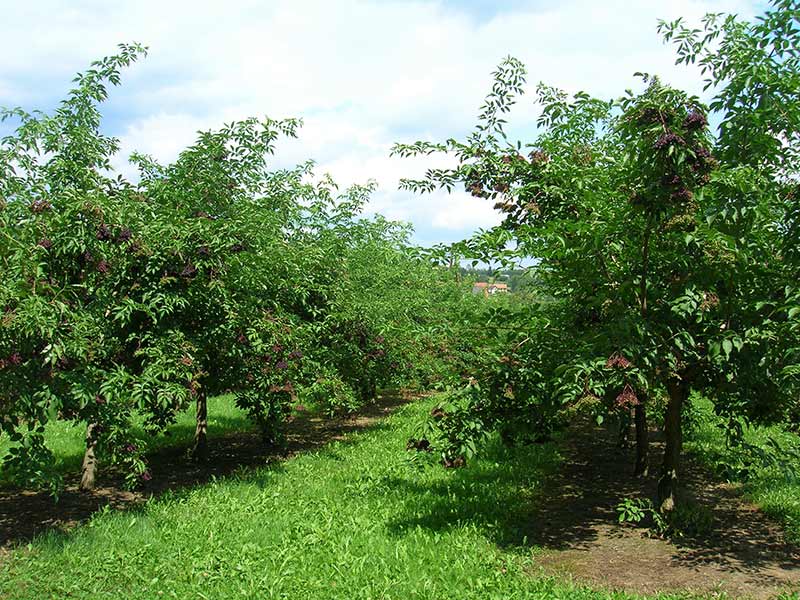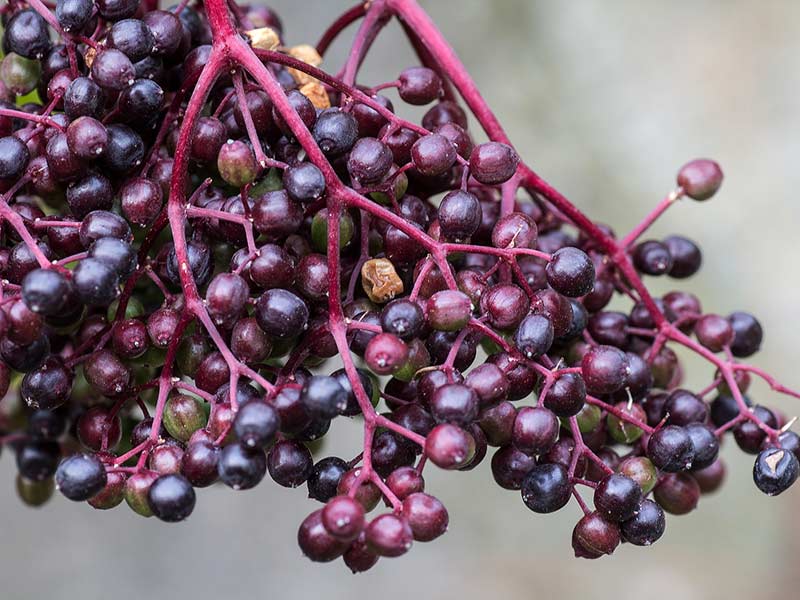Elderberry growing in South Africa
ELDERBERRY (European Black Elder)- Sambucus Nigra
It is a truly multi-purpose plant and can be used for a hedge, wildlife attractant, landscaping and for their abundance of fruit. This elderberry plant is easy to grow, care for and can grow up to 9m high within a very few short years which makes it a very good alternative for an organic, cost-effective and low maintenance windbreaker.
This variety is self-pollinating but will bear even better quality fruit when pollinated with another elderberry plant.
Elderberry fruit is a glossy dark purple to black berry, 5-6 mm in diameter, produced in drooping, sometimes very numerous clusters in late summer.
Landscape Value
Other than its beauty and improving air quality, it can serve as a windbreaker, assist in soil erosion and provide wildlife habitat.
Elderberry uses:
This variety is often used for health benefits as it is the only variety where the fruit is considered to be non-poisonous even when it is not cooked. The fruit has many uses and is perfect for juicing, jams, tarts, deserts, cordials, wine, champagnes or fresh fruit. Extracts are also made for medicinal uses.
Like most other berries, elderberries are full of antioxidants and contain high amounts of Vitamin C which aid your immune system in preventing and fighting off colds and flu. It also contains good amounts of Iron and potassium, vitamin B6 and beta-carotene.

Health benefits:
Sambucus nigra with its common name European or Black Elder may be the cultivar most often used for medicinal purposes throughout the world. Modern research holds that elderberries may have anti-inflammatory, antiviral, and anti-cancer properties. Flavonoids are another ingredient that places elderberries in the category of “antioxidant-rich”, capable of preventing cell damage.
100 g of fresh elderberries carry 73 calories. These tiny berries possess several noteworthy health benefiting plant-nutrients such as pigment flavonoid anti-oxidants, anthocyanins, minerals, and vitamins that contribute immensely towards robust health and wellness.
The berries possess one of the highest anti-oxidant strength among edible berries. Just as in blueberries, their antioxidant value too largely comes from poly-phenolic flavonoid compounds such as flavonoids isorhamnetin, kaempferol and quercetin. Together, these compounds help scavenge free-oxygen radicals from the human body, and thereby can protect it from cancers, aging, degenerative diseases and infections.
Fresh elderberries are an excellent source of vitamin-C. 100 g carry 36 mg or 60% of the daily recommended intake levels of vitamin-C. Vitamin-C is one of the powerful water-soluble natural antioxidants which works against flu-infections. It is also well-known to help boost immunity.
Elderberries are also incredible sources of vitamin-A (provide 600 IU or 20% of RDA per 100 g), several times more than that of in other berries like blueberries and aronia berries (chokeberries). Vitamin A is an essential nutrient required for maintaining healthy mucosa and skin and is required for good eye-health. Consumption of natural fruits rich in flavonoids and vitamin-A may help protect from lung and oral cavity cancers.
The berries also carry relatively good amount of B-complex group of vitamins such as niacin, pyridoxine (18% RDI /100g), folates and pantothenic acid. These vitamins work as co-factors for those enzymes that help in the metabolism of carbohydrates, protein and fats.
Furthermore, they contain good amount of minerals like calcium, potassium, manganese, iron and phosphorus. Potassium is an important component of cell and body fluids that helps controlling heart rate and blood pressure. Manganese is used by the body as a co-factor for the antioxidant enzyme, superoxide dismutase. Iron is required for red blood cell formation.
Source: www.nutrition-and-you.com
Black Elderberry has been found to be effective against the H5N1 strain of Avian Flu (Bird flu) (Zakay-Rones et al 1995). More info here
Antiviral components of elderberry fruit extract were tested and found to effectively inhibit Human Influenza A (H1N1 virus) in vitro, possibly by blocking the ability of the virus to infect host cells. The extract was so effective, that researchers compared it with the prescription medications Amantadine and Oseltamivir (Tamiflu). The benefits were greater if a person took elderberry within 2 days after flu symptoms started. One study suggested that the elderberry extract called Sambucol could shorten flu duration by up to three days. More details can be seen here at the A Healthy SA and the Black Elderberry Info websites.
When the phenolic, anthocyanin, and antioxidant capacities of the elderberry were tested for free radical scavenging abilities, researchers found they had effects similar to blackberries, black raspberries and other small, deep-hued fruits. These flavonoids stimulate the body’s immune system to fight mucus build-up and chest congestion by releasing components that combat the pathogens that cause colds, flu, and bronchitis.
Studies indicate that antioxidants provide some protection against environmental damage such as ultra violet rays. This can help with to lowering the rate of skin aging. Antioxidants can also help to strengthen hair, nails, eyes, teeth and gums.
Elderberries are reputed to have diuretic and detoxifying properties and therefore also considered good for weight management.
Other traditional uses of elderberry flowers are as external antiseptic washes and poultices to treat wounds, and as an eye wash for conjunctivitis and eye inflammation.
It has also been used for cosmetic purposes due to the reputation of distilled elderberry flower water to soften, tone, and restore the skin. The flowers can also be steeped in oil to make a lotion that relaxes sore muscles and soothes burns, sunburn, and rashes.
Some doctors recommend that pregnant and breastfeeding women avoid eating elderberries.



Site selection and preparation:
The Elderberry is easy to grow. The plant should be placed in full sun, but tolerates party shade. A soil PH level of 5.5 – 6.5 is optimal. The plant prefers loamy to sandy soil, but will also tolerate clayey soil.
Spacing
1m between plants with 4-5m between rows
Interesting Fact:
Some of the active antioxidant ingredients in elderberries work directly on the pancreas to regulate insulin and glucose levels, either providing stability for people who suffer from diabetes or helping non-diabetics to avoid developing this terrible condition.
Irrigation
The Elderberry plant is drought tolerant, but 25mm irrigation per week is needed for optimum growth and fruit production during the summer season.
Fertilising your Elderberry plants
Elderberries respond well to fertilization. In addition to incorporating manure or compost before planting, apply additional fertilizer annually in early spring. Apply 250g of ammonium nitrate (or 500g of 10-10-10) for each year of the plant’s age, up to 2.0kg per plant. There are also good slow release organic fertilizers available on the market such as the VitaFruit 3:1:5 from Talborne Organics. Make sure to follow the specific label recommendations
Pruning
No pruning is needed in these first two years. After that, you can prune the elderberry bushes in the early spring by cutting them back and removing any dead branches.
Elderberries send up many new canes each year. The canes usually reach full height in one season and develop lateral branches in the second. Flowers and fruit develop on the tips of the current season’s growth, often on the new canes, but especially on laterals. Second-year elderberry canes with good lateral development are the most fruitful. In the third or fourth year, older wood tends to lose vigor and become weak. In late winter to early spring while the plants are dormant, remove all dead, broken or weak canes.
Harvesting and storage
When ripe, the entire cluster should be removed and the berries stripped from the cluster for use.
Pests and diseases
Tomato Ringspot Virus is among the most serious diseases affecting elderberries. It is spread by nematodes and through pollen transfer. Dandelions and some other weeds can also carry this virus. It results in weakened plants, reduced productivity and eventually plant death. To control the virus, the soil should be tested for nematodes prior to planting, and fumigated if necessary.
Stem and twig cankers (Cytospora, Nectria, and Sphaeropsis) are among the fungus diseases which can be controlled by pruning and burning of infected canes.
Powdery mildew can affect canes and berries in late summer and early fall. It results in a grey appearance on the berries, but does not lower the quality of the juice.
Leaf spotting fungi, thread blight, root rots, and Verticillium are among the less common diseases.
Birds are the major pest affecting elderberries. They eat the fruits and can be a serious problem in small plantings. Control measures include electronic systems such as the Bird Guard, prompt harvesting of ripe fruit, but the most effective means is netting.
Commercial growing- Yields
Total yields of up to 3800kg per hectare have been reported.

